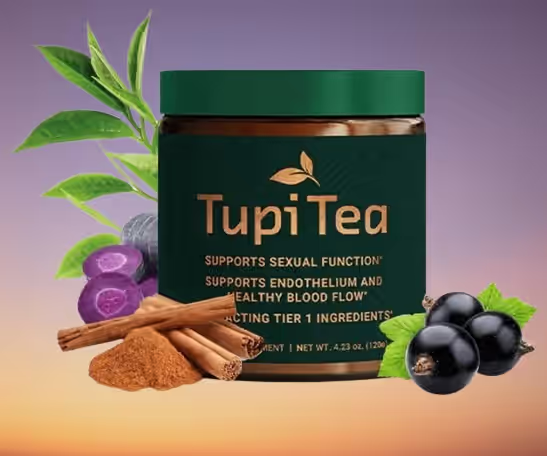Table of Contents
Lapsang souchong tea how to drink properly begins with understanding its remarkable history. This striking Chinese tea, with its distinctive smoky aroma, dates back to the 17th century during the Qing dynasty. Originally from the mountainous Wuyi region in China’s Fujian province, it’s considered the birthplace of both oolong and black teas.
Interestingly, this unique tea was discovered by accident. When bandits set fire to a tea farm in Tong Mu, farmers fleeing the Qing army needed to speed up the tea preparation process. Their solution? Drying the leaves in bamboo baskets over pinewood fires, allowing the leaves to absorb the smoke. In the Fuzhou dialect, the name itself tells the story—’Lap’ means pine and ‘Sang’ means smoke, while ‘souchong’ refers to a sub-variety.
Besides its fascinating history, lapsang souchong contains moderate caffeine (about 30-60 mg per cup), which helps improve brain function and increase alertness. When brewed, it produces a lush, red-to-ambery-brown liquid that doesn’t hint at the bold flavor experience awaiting your palate.
In this guide, we’ll explore everything you need to know about drinking this remarkable tea—from proper brewing techniques to pairing suggestions that complement its distinct character. Whether you’re a curious newcomer or a tea enthusiast looking to perfect your technique, we’ve got you covered.
What Makes Lapsang Souchong Unique
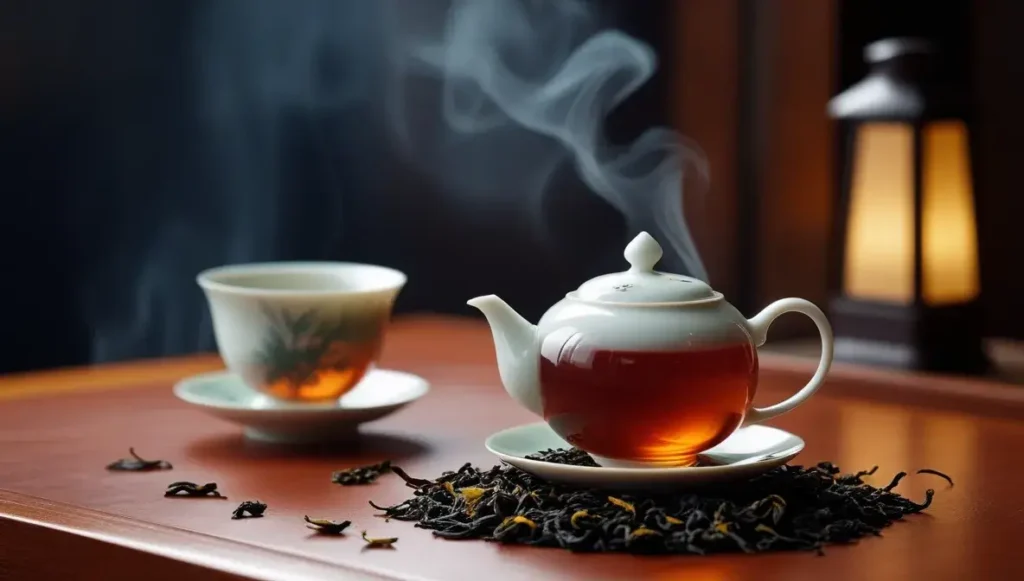
Discovering the unique qualities of lapsang souchong tea reveals a fascinating journey through Chinese tea history. Undoubtedly, its distinctive characteristics set it apart from other teas worldwide.
The origin story from Wuyi Mountains
The birthplace of lapsang souchong lies in Tongmu Guan, nestled within the misty Wuyi Mountains of Fujian Province in southeast China. This remarkable tea is revered as the ancestor of all black teas. Historical records trace the area’s tea production back to the Song Dynasty, initially focusing on green tea varieties and tung oil production. In fact, the name “Tongmu” itself derives from the abundance of tung trees in the region.
The exact origins date to approximately 1568-1646 AD during the Ming and Qing dynasties. This period marked significant historical upheaval in China, inadvertently leading to one of the world’s most distinctive teas. As with many legendary creations, lapsang souchong’s birth arose from necessity rather than deliberate invention.
How the smoking process began
Several accounts explain lapsang souchong’s creation, though most share common elements. The predominant story tells of military troops passing through Tongmu during tea-picking season. According to one version, soldiers camped at a tea farmer’s house, causing him to flee. Upon returning, he discovered his fresh leaves had oxidized to brown.
Alternatively, some accounts suggest soldiers directly slept on freshly harvested leaves intended for green tea processing. Regardless of the precise circumstances, tea farmers faced a dilemma: how to salvage these altered leaves.
The solution proved ingenious. Farmers dried the leaves over pine wood fires, originally to speed the process. This method utilized the abundant pine forests surrounding Tongmu, creating a traditional processing system. Master producers later refined this technique using a three-story woodshed called “Qinglou”. Inside this structure, pine wood burns in a stove while tea leaves placed on bamboo mats absorb the aromatic smoke as it rises through wooden slats between floors.
What ‘souchong’ really means
The name itself offers clues to the tea’s character. “Souchong” derives from Chinese, literally meaning “small sort”. The term first appeared in English around 1750 and specifically refers to the fourth and fifth leaves harvested from the tea plant.
These larger, more mature leaves grow further down from the prized buds at the tips. Though once considered somewhat inferior to the delicate top leaves used for premium teas, these hardy souchong leaves proved ideal for smoking, creating a prized product in their own right.
👉 Discover premium lapsang souchong tea for unparalleled smoky delight 👈
Understanding the Flavor and Aroma
The extraordinary sensory experience of lapsang souchong begins well before the first sip touches your lips. From the moment you open the package, this distinctive tea captivates your senses with an intensity that demands attention.
Smoky, piney, and earthy notes
Lapsang souchong’s signature flavor stems primarily from two chemical compounds—longifolene and α-terpineol—which occur exclusively in this tea variety due to its unique production method. The pine smoke infusion creates a complex profile featuring sweet, refreshing smokiness with a crisp, lightly evaporating finish.
Beneath the dominant smoky character lies a surprising depth. Many tea connoisseurs detect underlying notes of earthiness, maltiness, and subtle sweetness that balances the robust smoke. The tea presents a light-bodied experience with a heady, piney aroma that evokes memories of forest campfires. Upon tasting, you’ll discover hints of pine resin and smoked paprika that create a truly distinctive character.
Comparisons to whiskey and barbecue
Tea enthusiasts frequently describe lapsang souchong as “the barbecue of tea”. Its deep, smoky profile draws natural comparisons to other bold flavored luxuries. Many liken the experience to sipping fine Scotch whiskey minus the alcohol. The drinking experience parallels enjoying high-quality peated whiskey, with similar woody notes and warming sensation.
Chefs have embraced this similarity, incorporating lapsang souchong into cooking to impart barbecue-like flavors without using smoked meat. The tea’s complex profile of pine, fruit, and mellow sweetness makes it remarkably versatile beyond the teacup.
Why it’s considered an acquired taste
Much like fine cigars or aged whiskey, lapsang souchong rarely elicits neutral reactions. Some tea drinkers find themselves simultaneously intrigued and repelled by its powerful character. The pungent, tarry flavor and intense aroma can initially overwhelm those accustomed to milder teas.
For newcomers, the first encounter might seem overpowering—even comparable to liquid smoke. Nevertheless, many who persevere discover a growing appreciation for its distinctive character, eventually developing a refined palate for this boldest of teas.
How to Brew Lapsang Souchong Tea
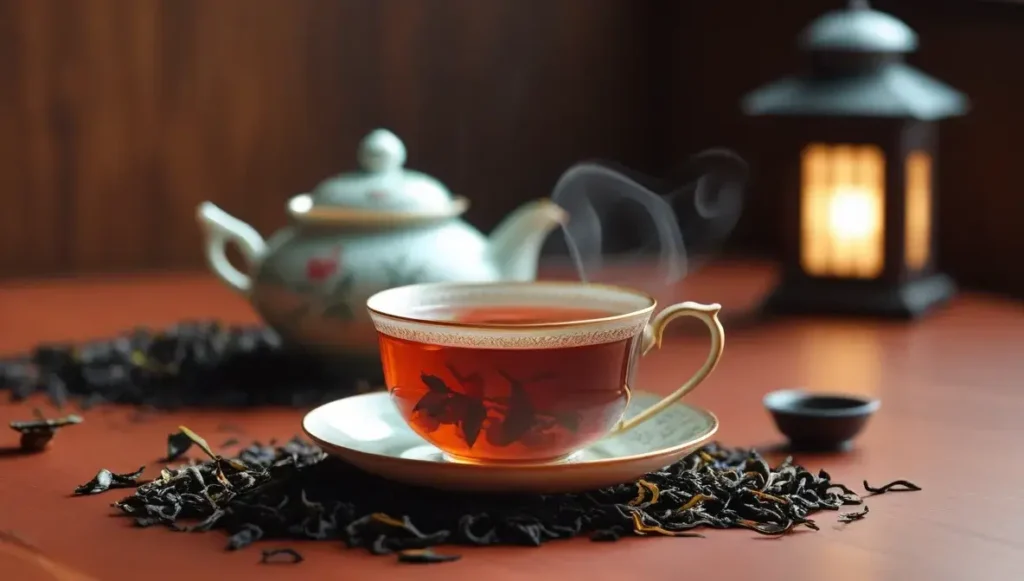
Brewing the perfect cup of lapsang souchong requires attention to detail and proper technique. Mastering these elements unlocks the full complexity of this distinctive tea’s character and ensures an exceptional drinking experience.
Choosing loose leaf vs tea bags
Loose leaf lapsang souchong consistently delivers superior quality compared to tea bags. Tea aficionados primarily recommend loose leaf because it contains whole tea leaves that offer greater health benefits and fuller flavor. Conversely, tea bags typically contain broken leaves, fannings, and dust—essentially the leftover fragments after processing higher-quality leaves. The unrestricted movement of loose leaves through water allows better diffusion of flavor molecules, creating a more nuanced cup. Additionally, loose leaf can be steeped multiple times, making it more economical despite the higher initial cost.
How long to steep Lapsang Souchong
The ideal steeping time for lapsang souchong typically ranges between 1-5 minutes, with 2.5 minutes generally considered the sweet spot. For beginners, start with a shorter steeping time (2-3 minutes) and sample the tea, allowing it to brew until it reaches your preferred level of smokiness. Essentially, longer brewing times produce stronger, potentially more bitter blends, whereas shorter infusions may lack the balanced interplay between earthy notes and smoky essence. Your personal preference should guide this decision—experiment until you discover your ideal balance.
Water temperature and steeping tools
For optimal results, use water heated to approximately 212°F (full boil) or slightly cooler at 203-205°F. Always choose filtered or spring water rather than tap or distilled varieties, as water quality significantly impacts flavor development. Pre-warm your teapot by rinsing it with hot water before adding tea leaves—this prevents temperature fluctuations that inhibit full flavor extraction. Measure about 5 grams (approximately 1-2 teaspoons) of tea per 8 ounces of water. Regarding teaware, traditionalists often prefer clay Yixing pots, although glass, porcelain, and cast iron options also work well.
Hot brew vs cold brew methods
Cold brewing offers an alternative preparation method that highlights different aspects of lapsang souchong’s flavor profile. To cold brew, simply combine tea leaves with room temperature water in a glass container, using the same tea-to-water ratio as hot brewing. Cover and refrigerate for at least 12 hours. Unlike hot-brewed tea, cold brew doesn’t develop cloudiness. Alternatively, create a concentrated cold brew by using half the recommended water amount, allowing it to cool completely, then pouring over ice for immediate enjoyment.
Tips for re-steeping leaves
One remarkable advantage of quality lapsang souchong is its ability to withstand multiple infusions. Typically, you can re-steep loose leaves 2-3 times, with each infusion offering slightly different character. For subsequent steeps, increase brewing time—for instance, from 5 minutes initially to approximately 8 minutes for the second infusion. However, be mindful that flavors may eventually degrade rather than unfold if pushed too far. Throughout multiple steepings, adjust time and dose to attenuate smokiness and elevate other desirable flavors.
👉 Try the best lapsang souchong tea for rich bold flavor 👈
How to Drink and Enjoy It
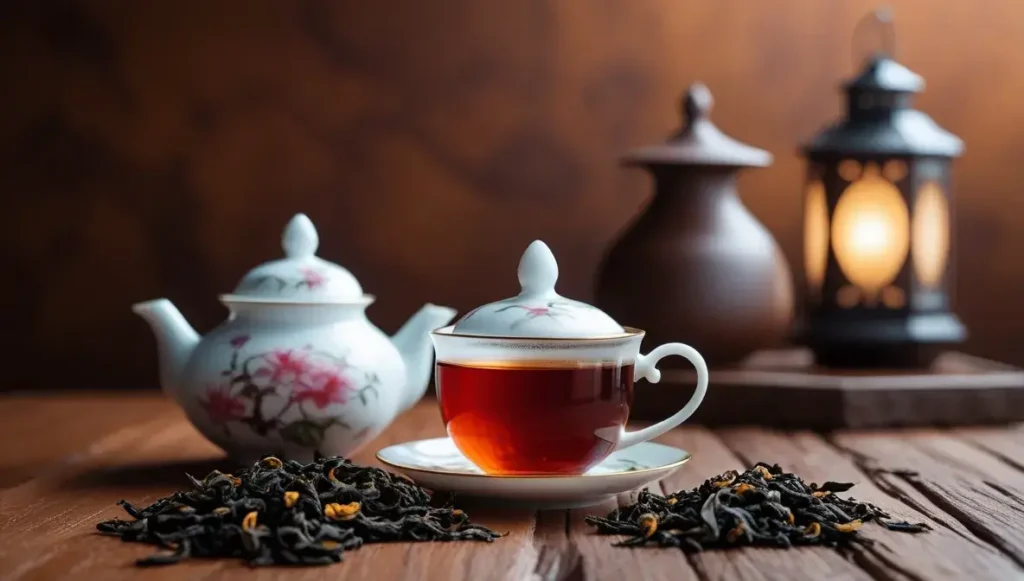
“Tea is the drink of the gods, the elixir of life, the essence of love and friendship.” — Kakuzo Okakura, Author of ‘The Book of Tea’, influential Japanese art scholar and tea philosopher
Once you’ve mastered brewing lapsang souchong tea, exploring different ways to enjoy this distinctive beverage unlocks its full potential. Traditionally consumed for its unique smoky character, lapsang souchong offers versatility that extends well beyond the teacup.
Drinking it plain vs with milk or honey
Traditionally, lapsang souchong is consumed as-is, allowing you to fully appreciate its bold, smoky notes without interference. This purist approach lets the tea’s distinctive character shine through. Moreover, those finding the flavor too intense can soften the experience with various additions. A splash of milk creates a creamier experience that mellows the smokiness, particularly helpful for newcomers to this acquired taste. Alternatively, a dash of honey or vanilla enhances the smoky profile without masking it. For a brightness that complements the tea’s depth, try adding a slice of lemon. Maple syrup serves as another excellent sweetener option, as it provides a softer undertone than honey without overwhelming the tea’s natural character.
Pairing with food: sweet and savory options
Lapsang souchong’s robust character makes it an exceptional companion for various foods. On the savory side, the tea naturally complements broiled meats, barbecue dishes, and smoked foods. Its smoky notes particularly enhance the flavor of charred steaks and grilled ribs. Furthermore, hard cheeses like Gouda create a wonderful contrast against the tea’s boldness. For sweet pairings, dark chocolate stands out as a remarkable match, with the bitterness of the chocolate balancing the tea’s intensity. Spiced cookies, fruit preserves, and roasted nuts offer additional sweet-leaning options that work surprisingly well.
Best times of day to enjoy Lapsang
Lapsang souchong particularly shines during colder months, imparting a cozy, pleasant drinking experience that warms from within. The tea’s smoky quality evokes feelings of sitting beside a crackling fire, making it ideal for winter mornings. As a morning brew, it provides a caffeine boost coupled with an energizing campfire-like aroma. For an afternoon pick-me-up, pair it with savory or sweet snacks. Evening enjoyment calls for a lighter brew that offers the soothing smoky flavor without excessive caffeine.
Using it in cooking and cocktails
Beyond drinking, lapsang souchong excels as a culinary ingredient. Chefs incorporate it into spice rubs, marinades, and sauces to impart barbecue-like flavors without using smoked meat. The tea works wonderfully as a base for creative cocktails. A popular lapsang souchong cocktail combines:
- 1.5 fl oz cold lapsang souchong tea
- 1.5 fl oz Hendricks Gin
- Premium tonic water
- Ice and a twist of orange or lemon
Another intriguing option is a lapsang souchong old fashioned, where the tea’s smokiness beautifully complements bourbon with muddled citrus and honey syrup.
Conclusion: Lapsang Souchong Tea How to Drink for Rich, Smoky Flavor
Lapsang souchong stands as a truly unique addition to the world of tea, offering an experience unlike any other. Throughout this guide, we’ve explored its fascinating accidental origins in China’s Wuyi Mountains, where pine smoke transformed ordinary tea leaves into something extraordinary. Additionally, we’ve uncovered the complex flavor profile that makes this tea so distinctive – that perfect balance of smokiness, pine, and subtle sweetness that evokes comparisons to fine whiskey and barbecue.
Proper brewing techniques certainly make all the difference when preparing lapsang souchong. Water temperature, steeping time, and quality tea leaves work together to create the perfect cup. Whether you prefer it hot brewed in a traditional manner or cold brewed for a different flavor experience, this versatile tea rewards experimentation and patience.
The enjoyment of lapsang souchong extends far beyond simply drinking it plain. Though purists might prefer it unadulterated, adding milk, honey, or other complementary flavors can create entirely new experiences. Furthermore, its bold character pairs wonderfully with both savory and sweet foods, making it an excellent companion for meals throughout the day.
Perhaps most surprisingly, lapsang souchong transcends the teacup altogether. Chefs and mixologists have discovered its potential as a culinary ingredient and cocktail component, proving this tea’s remarkable adaptability.
For anyone new to this distinctive brew, remember that lapsang souchong often becomes an acquired taste. Your first encounter might seem overwhelming, but subsequent cups often reveal new layers of complexity and enjoyment. Therefore, we encourage you to approach it with an open mind and adventurous spirit.
Whether you seek a warming companion for cold winter mornings or a unique ingredient for your next culinary creation, lapsang souchong delivers an unforgettable sensory experience. After all, few teas can claim such a perfect balance of history, character, and versatility – all waiting to be discovered in your next cup.
👉 Experience top-rated lapsang souchong tea and awaken your senses 👈
Key Takeaways
Master the art of brewing and enjoying lapsang souchong, the world’s most distinctive smoky tea, with these essential insights for tea enthusiasts.
• Brew at 212°F for 2-3 minutes – Use loose leaf tea with boiling water and shorter steeping times to avoid overwhelming bitterness while preserving complex smoky flavors.
• Start plain, then experiment with additions – Drink it pure first to appreciate its unique character, then try milk or honey to mellow the intensity for beginners.
• Perfect for cold weather and hearty foods – This robust tea shines in winter months and pairs excellently with barbecue, dark chocolate, and smoked meats.
• Reuse leaves 2-3 times for maximum value – Quality lapsang souchong can be re-steeped multiple times, with each infusion revealing different flavor nuances.
• Versatile beyond the teacup – Use it as a culinary ingredient for marinades and spice rubs, or create unique cocktails that showcase its smoky complexity.
Remember that lapsang souchong is an acquired taste – what might seem overwhelming at first often develops into a deeply appreciated complexity. This accidentally discovered tea from China’s Wuyi Mountains offers a sensory journey unlike any other beverage, combining centuries of tradition with modern versatility.
FAQs
Q1. How should I brew Lapsang Souchong tea for the best flavor? For optimal flavor, use loose leaf tea and brew with water at 212°F (100°C) for 2-3 minutes. Start with a shorter steeping time and adjust to your taste preference. Use about 1-2 teaspoons of tea per 8 ounces of water.
Q2. Can I add milk or honey to Lapsang Souchong tea? While traditionally enjoyed plain, you can add milk or honey to soften the intense smoky flavor, especially if you’re new to this tea. A splash of milk creates a creamier experience, while honey can enhance the smoky profile without masking it.
Q3. What foods pair well with Lapsang Souchong tea? Lapsang Souchong pairs excellently with savory foods like grilled meats, barbecue, and smoked cheeses. For sweet options, try it with dark chocolate or spiced cookies. Its robust flavor complements a wide range of cuisines.
Q4. Is Lapsang Souchong tea good for you? Lapsang Souchong contains moderate caffeine (30-60 mg per cup) which can improve brain function and increase alertness. Like other teas, it may offer various health benefits, but it’s best to enjoy it as part of a balanced diet.
Q5. Can Lapsang Souchong tea be used in cooking or cocktails? Absolutely! Lapsang Souchong is versatile beyond drinking. It can be used in cooking as a spice rub or marinade to impart smoky flavors. In mixology, it’s popular in cocktails like smoky old fashioneds or unique gin and tonic variations.
👉 Elevate your brew with the ultimate lapsang souchong tea blend 👈
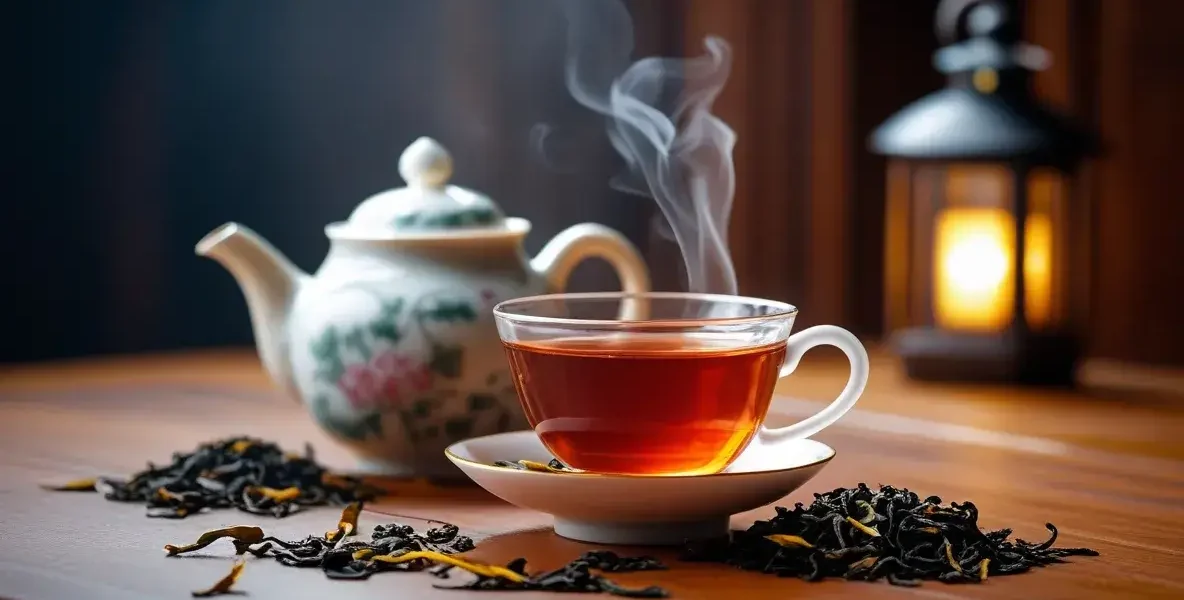


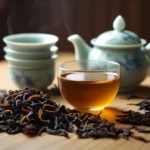
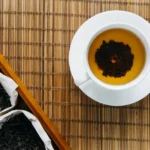

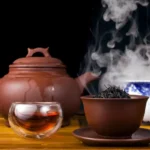

![Pu Erh Tea vs Green Tea: Which is Better for Daily Health? [2025] pu erh tea vs green tea](https://www.goteaworld.com/wp-content/uploads/2025/10/pu-erh-tea-vs-green-tea-150x150.webp)

![Jasmine Tea vs Green Tea Benefits: Which Gives Better Health Results? [2025] jasmine tea vs green tea benefits](https://www.goteaworld.com/wp-content/uploads/2025/09/jasmine-tea-vs-green-tea-benefits-150x150.webp)


